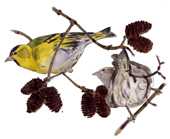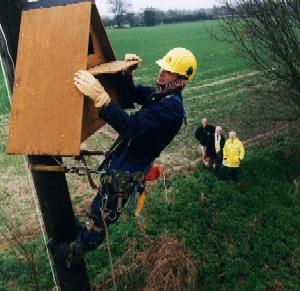
| If you look under the Alder (Alnus glutinosa) or high up in the canopy of these trees you may well see a small flock of yellow and black finches called Siskins (Carduelis spinus) that specialise in extracting the seeds from the Alder cones. They visit they Moors during the winter from northern UK, Scandinavia and Europe. |  |
 |
In the spring of 1999, a number of large bird nest boxes were erected on poles across The Moors with the aim of encouraging species such as Kestrels (Falco tinnunculus), owls and Stock Doves (Columba oenas) to breed. Barn Owls (Tyto alba) can sometimes be seen hunting over the fen late on summer evenings as they look for small mammals to feed their young. Barn Owls are typical birds of river valleys where they can do very well if enough vegetation is left uncut or ungrazed to provide habitat for small mammals. |
|
Unfortunately, Barn Owls declined dramatically across Europe during the late 20th Century. The causes include loss of habitat and nest sites, increased traffic on roads resulting in more road casualties and the widespread use of poisons on farms to control rodents. However, they do seem to be making a comeback across Britain, due partly to the provision of wildlife headlands around fields and nestboxes in suitable locations. For information about the conservation of Barn Owls visit the Barn Owl Trust website www.barnowltrust.org.uk As part of the biological monitoring programme
at The Moors reserve, the nest boxes are checked several times each summer
and the contents recorded as part of the British Trust for Ornithology's
(BTO) Nest Record Scheme. Young birds are ringed as part of the national
Bird Ringing Scheme administered by the BTO to help with the monitoring
of species such as Barn Owls in the UK. To find out more about the work
of the BTO visit its website at www.bto.org |
|
|
The video clip shows a sequence of the development of a brood of Barn Owls in a box over a 48 day period. Barn Owls usually fledge after spending 10 weeks in the nest. |
|